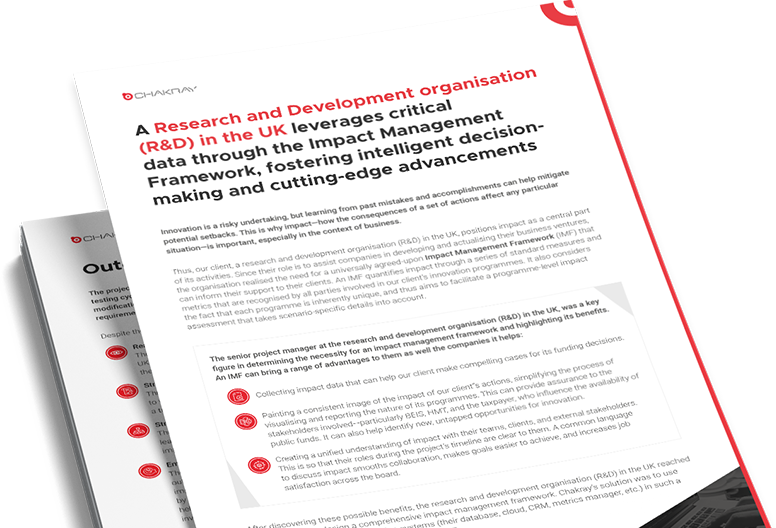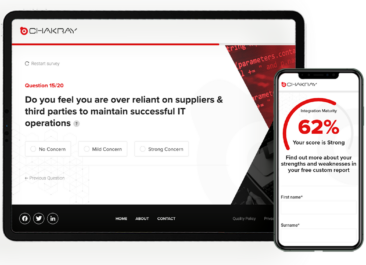
Introduction
Innovation is a risky undertaking, but learning from past mistakes and accomplishments can help mitigate potential setbacks. This is why impact—how the consequences of a set of actions affect any particular situation—is important, especially in the context of business.
Thus, our client, a research and development organisation (R&D) in the UK, positions impact as a central part of its activities. Since their role is to assist companies in developing and actualising their business ventures, the organisation realised the need for a universally agreed-upon Impact Management Framework (IMF) that can inform their support to their clients. An IMF quantifies impact through a series of standard measures and metrics that are recognised by all parties involved in our client’s innovation programmes. It also considers the fact that each programme is inherently unique, and thus aims to facilitate a programme-level impact assessment that takes scenario-specific details into account.
The senior project manager at the research and development organisation (R&D) in the UK, was a key figure in determining the necessity for an impact management framework and highlighting its benefits. An IMF can bring a range of advantages to them as well the companies it helps:
- Collecting impact data that can help our client make compelling cases for its funding decisions.
- Painting a consistent image of the impact of our client’’s actions, simplifying the process of visualising and reporting the nature of its programmes. This can provide assurance to the stakeholders involved—particularly BEIS, HMT, and the taxpayer, who influence the availability of public funds. It can also help identify new, untapped opportunities for innovation.
- Creating a unified understanding of impact with their teams, clients, and external stakeholders. This is so that their roles during the project’s timeline are clear to them. A common language to discuss impact smooths collaboration, makes goals easier to achieve, and increases job satisfaction across the board.
After discovering these possible benefits, the research and development organisation (R&D) in the UK reached out to Chakray to design a comprehensive impact management framework. Chakray’s solution was to use WSO2 to integrate their pre-existing systems (their database, cloud, CRM, metrics manager, etc.) in such a way that it executes the business logic for an IMF.

The Solution
The research and development organisation (R&D) in the UK, with the help of Chakray’s team, came up with a solution that utilised WSO2 Micro Integrator and an Amazon Simple Storage Service (Amazon S3) to build a Systems Integration Layer (SIL).
This module handles the complex flow and transformations of data to and from our client’s digital resources.
- WSO2 Micro Integrator layer contains scheduled tasks that initiate some business logic through proxy services. All services are written to support an implementation of a microservices architecture in the future, but are hosted as monolithic instances in the current environment.
- AWS S3 buckets are used to track each transaction and log them as either passed or failed, both in the staging and production environments.
The main goal of the solution architecture given below is to handle surveys filled out by the research and development organisation’s clients at different points of their interaction with the company:
-
A Government Digital Service (GDS) style survey is delivered to users via Salesforce.
- The survey’s questions are uploaded from the Metrics Manager (MM) application to Salesforce either as a temporary record or a new record/update to an existing record. Once a new record is established, an internal trigger deletes the temporary record and modifies any existing records as per the new data. This will reflect as a survey with new questions to the users.
- A survey is sent during the pre-approval and post-approval phases of the R&D organisation’s project with its client. Pre-approval and post-approval surveys are flagged as such (both at the survey header level and the individual question level) when they are sent from the MM to Salesforce. This is so that both the surveys and the questions are properly identified and sent during the appropriate project stage.
- Usually, the pre-approval and post-approval surveys are the same. However, in the case of any new post-approval survey questions, they are added on top of the existing pre-approval survey questions. The surveys from the post-approval stage to the later stages sometimes include additional project-related fields that don’t appear in the pre-approval stage survey.
- When a client of the R&D organisation has completed the pre-approval survey (we identify this by checking if the survey’s pre-approval flag is marked as ‘true’) and the project has gone live, a postapproval survey is sent to the R&D organisation’s client. They can navigate to the survey—all of which are hosted on Salesforce. Once the post-approval survey is completed by the R&D organisation’s client, the survey’s post-approval flag is marked as ‘true’.
- Similarly, once the project is completed, closure and post-closure surveys are set up.
- The Metrics Manager polls the status of the project as well as participant (client) information from Salesforce to coordinate the mapping of questions and track survey stages. It also receives application and location information from the Innovation Funding System, which manages the projects and project states. The IFS also tracks the number of surveys returned so that it can set up the project records.
- Competition information (this covers the type of support that the research and development organisation (R&D) in the UK provides its clients; for example, grants and loans) will be sent from Salesforce CRM to Janus DB.
Architecture of an Impact Management Framework
The client was happy with this solution proposed by Chakray. They hoped for a digitised service that helps establish an evidence and data driven culture to bring to life their vision of impact at the heart of their activities. The Systems Integration Layer aimed to do just that by bridging data silos and making client-level data more centralised and readily accessible.

Outcomes
The project faced some delays due to constant changes to the design and unavailable resources during the testing cycle. Enforcing a more complete solution architecture at the beginning of the project to minimise modifications, controlling the number of change requests during production, and managing and confirming requirements more effectively will make any future additions to the project an even bigger success.
Despite these minor difficulties, there were many positive outcomes that the IMF project has accomplished:
- Realising their Vision: The adoption of the Framework now empowers the research and development organisation (R&D) in the UK to effectively monitor their investments and funded initiatives, precisely gauging their contribution to the project’s objectives.
- Strengthened accountability and transparency:Through the implementation of a standardised framework, our client is able to showcase accountability to various stakeholders, including the government, project partners, and the public. The IMF establishes a transparent and consistent approach to measure and report impacts, fostering trust and credibility.
- Structured approach to project evaluation:The IMF allows our client to comprehensively assess the results and consequences of funded projects, leading to a more thorough evaluation of project success and the identification of areas where improvements can be made.
- Empowered decision-making: The IMF empowers our client to make informed decisions regarding project funding. By analysing the outcomes and effects of previous projects, the R&D organisation can pinpoint areas with significant impact and fund future projects based on whether they meet their strategic priorities. As confirmed by our client’s Chief Operating Officer: “Being able to report to the entities on the impact we are having helps us demonstrate value for money and allows us to make evidence-based decisions about future investment so we can do what we do best – strengthen our economy through innovation.“

About the project
The Technologies
The following technologies were required to deliver the desired outcomes:

About the client
As an R&D organisation in the UK, they are focused on guiding businesses in their quest to bring their ideas to life. The aim of their interventions is to lead companies to their end goal whilst guaranteeing that their endeavours yield positive change—beneficial economic, environmental, or social outcomes within and outside the limits of the business.









